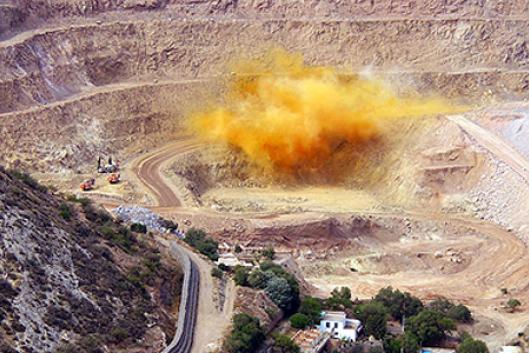By MovimientoM4*
Without a doubt, implementation of the extractive industries model as part of governments' "development" option counteracts existing international and regional efforts to buffer the climate and environmental crisis. With cynicism and deceit, they violate the most basic international treaties and agreements that aim to minimally stop the destruction of the environment and biological diversity.
The extractive mining model is undoubtedly the mega-project with the biggest territorial impact. It steamrolls human rights and the products nature provides, encourages grabbing and dispossession of land, and is therefore a "natural" promoter of the destruction of Mother Earth.
Mesoamerica stands out globally for its huge biological and cultural diversity, not only for its ancient pre-Columbian history. Its location near the equator creates unique conditions that produce a wealth of natural products and water reserves, and makes it home to native endemic and endangered species not found in any other part of the planet. Its mountainous regions stand out, including the Sierra Madre in Mexico (West and East) which spans a large part of the country; the Cuchumatanes mountains in Guatemala; and the Central Volcanic and Talamanca ranges in Costa Rica and Panama. Here, in these mountains life is diverse, nature is multi-faceted, and Mesoamerican peoples have contributed to their management and domestication of native species to establish historic bio-cultural processes. All of this means biodiversity.
The wealth of biodiversity in Mesoamerica is threatened by neoliberal integrationist projects, like the "Plan Puebla-Panamá"—now called "Mesoamerica Integration and Development Project"—and other commercial integration projects which are nothing more than companies' and multinational actors' plans to commodify nature at any cost. The "Mesoamerica Integration and Development Project" aims to progressively create the ideal conditions to facilitate private national, foreign and multinational investment. It is therefore no coincidence that there is talk of large infrastructure projects—like highways, railways, airports and seaports—as well as increased energy production through mega-dam substations or wind farms. Without these infrastructure, communication, and energy projects, investments would simply freeze, and companies would not come or be able to operate. Additionally, large amounts of natural goods—like water—are needed, which in some cases like mining projects, are essential for their establishment and operation. It is therefore no coincidence that the energy integration system involves homogenizing the region's transmission lines . Meanwhile, each country moves to deregulate its laws and regulations, to later create new ones that accommodate the business sector. (1)
The impacts of deregulation are multi-faceted, yet one only needs to observe the thousands of mining concessions associated with energy projects—authorized arbitrarily by governments and directly threatening this land—to get an idea of what we're talking about.
In this context, the destructive mining projects of Canadian company GoldCorp—such as the Marlin Mine in Guatemala, the San Martín Mine in Valle de Siria, Honduras, or the Los Filos mining complex in Carrizalillo, Mexico—clearly demonstrate how opencast mining epitomizes the devastation caused by the extractive model. In these countries, opencast mining has contaminated rivers through a leaching process (the use of sodium cyanide to extract minerals like gold, silver and copper) and has caused major environmental liabilities through use of toxic heavy metals, which cause irreversible damage to the health of people, animals and the environment.
Nonetheless, and despite the huge efforts of financial institutions, governments and mining corporations to make people believe mining is the only way to develop, people have built diverse forms of resistance to stop the expansion of mining and demystify the discourse of "progress and development" that the extractive model promotes and imposes. They have achieved this through peaceful, democratic and legal processes, with a strong basis in their self-determination.
The dominant economic model is voracious and mercantilist when it comes to nature, which it defines as "strategic" (water, minerals, air, land). This extractive model seeks to reduce nature's significance to the point where a forest is seen only as a producer of wood and energy sources, and a mountain as a collection of minerals and precious metals. From this standpoint, the vision of ecosystems as a whole is lost. Meanwhile, indigenous peoples have historically seen nature as a whole, in which forests, rivers and all of Mother Earth are inter-connected. Their worldview connects the earthly with the otherworldly, and is the essence of life itself. It is no coincidence therefore, that in the face of the predatory extractive model, resistance movements respond in defense of life itself, to guarantee the continued existence of the great natural wealth that still remains in the region.
Francisco Mateo, member of the Guatemalan Council of Mayan Peoples
Miguel Angel Mijangos, member of Integral Processes for Peoples' Self-Management
Members of the Mesoamerican Movement Against the Extractive Mining Model (Movimiento M4, by its Spanish abbreviation)
Contact: info@movimientom4.org
